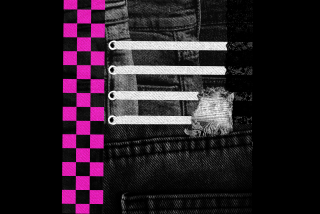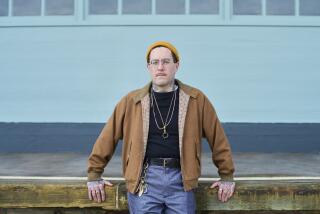BOOK MARK : When the Racist Skinheads Debuted, They Identified With Black Culture : <i> “Blood in the Face” tells about racist far-right movements in Europe and America, which have expanded in the last decade. This excerpt tracks the skinheads from London to California.</i>
The fact that the Nazi skinheads have become the shock troops of the rightist resurgence in Europe as well as in America over the past five years or so is a historical irony of loopy proportions. When bands of male teen-agers--all wearing high-laced work boots, suspenders, short or rolled-cuff jeans and plaid shirts, their hair shaved close to the skull--began appearing in London streets in the late 1960s, they were actually identified with black culture.
Skins were at first considered a splinter of the Mods, a fashion culture that dominated the rock ‘n’ roll society of the time. The Mods, like the New Wavers of the early 1980s, carried neatness and apparent conformity to the point of absurdity--a Mod would wear a necktie like any businessman, but it would be too narrow to be quite normal.
The inspiration for their dandyism lay in black culture. Mods saw black men like James Brown and Smokey Robinson as more than outposts of Soul--they were viewed as men who had escaped their class, wise to their irredeemably low status within society, but somehow able to outwit their betters by enjoying life more intensely.
In the late 1960s and the early 1970s, one group of Mods veered into hippiedom; another, the “hard Mods,” sporting heavy boots, jeans and short hair, turned away from acid rock and got into ska, rocksteady and reggae. Where the Mods had been upwardly mobile, the skins, dressed as a kind of caricature of the model worker, explored the lumpen proletariat, creating a fused identity out of the culture of West Indian immigrants and the white working class.
Black West Indian culture was “armored against contaminating influences, protected against the more frontal assaults of the dominant ideology, denied access to the ‘good life’ by the color of its skin,” (wrote British author Dick Hebdige in “Subculture: The Meaning of Style.”) “Its rituals, language and style provided models for those white youths alienated from the parent culture by the imagined compromise of the postwar years.”
This was a pretty chancy alliance that needed continual monitoring. Solidarity was underscored by venting aggression on other, even more alien groups such as homosexuals, hippies and Asians. “Less easily assimilated than the West Indians into the host community,” wrote Hebdige, “sharply differentiated not only by racial characteristics but by religious rituals, food taboos and a value system which encouraged deference, frugality and the profit motive, the Pakistanis were singled out for the brutal attentions of skinheads, black and white alike. Every time the boot went in, a contradiction was concealed, glossed over, made to ‘disappear.’ ”
As the ‘70s wore on, and what was left of working-class society went down the drain in Britain, the skinheads--like most of the rest of youth culture--found themselves “boutiqued” past all meaning, marketed as a look. The threat of being co-opted by the larger culture accentuated the downwardly mobile, exaggeratedly proletarian tendencies among skinheads, reinforcing their chauvinism and puritanical rejection of consumerism. The more extreme expressions of skinhead disaffection, such as slam-dancing and “Paki-bashing,” assumed increased importance. And the one distinguishing mark of the skinhead vision--its mixture of immigrant and downscale white cultures--foundered, as any sense of interracial communality broke down. Without their dialogue with blacks, white skinheads, Hebdige writes, suddenly found themselves “sentenced to perpetual adolescence”--and, often, to White Power.
In contrast to Britain and Western Europe, in America the skinheads are a suburban and small-town phenomenon. Although their class associations remain roughly intact, the less class-conscious American setting confers a more generalized, bully-boy air to skin rituals, and the deeper patterns of housing segregation in outlying areas make them far more vulnerable to separatist rhetoric. American skinheads are also often more purposefully violent.
The Anti-Defamation League, which has issued a series of detailed studies of the skinhead movement in the United States, reported, in 1989, that there were about 3,000 activist skinheads in 31 states, most concentrated in the West and, to a lesser extent, in the South. In California, the center of most skinhead activity, the ADL counted between 30 and 40 activists in San Diego’s WAR (White Aryan Resistance) Skins. Orange County had as many as 200 skins in 10 different gangs, whose members drift from one community to another, hanging out on beaches or in shopping malls.
. . . Like most youth gangs, the skins place a high value on conforming to the group consensus--as their boot-camp haircut and rolled-jeans uniform suggests--and they reserve their most violent behavior for the fallen faithful.
Greg Withrow founded the White Student Union at American River College in Sacramento in 1979. Later, in an effort to tie his skins to former Ku Klux Klan grand dragon Tom Metzger’s White Aryan Resistance, he added “Aryan Youth Movement” to its name.
But in 1987, Withrow found the love of a good woman, and under his girlfriend’s influence he rejected his racist ways and went on television to denounce the racist movement. He announced plans to write an expose. At that, Withrow’s former colleagues broke into his apartment and beat him with baseball bats, stealing a copy of his manuscript as they departed.
Later that summer, as Withrow was leaving his apartment to go for an evening walk, a blue pickup truck screeched to a halt alongside him, and six members of the neo-Nazi group he had founded jumped out. They started beating and kicking him. Dragging him into an empty lot, they tied his arms to a board. “They told me I was a traitor,” he recalled, “and they held a gun to my head. Then they began to hammer nails in my hands. It seemed like they hammered forever, real slow. They told me they were doing it so I wouldn’t write anymore.”
Then one of his former colleagues pulled out a razor blade and cut a foot-long gash in Withrow’s chest just below his neck. “That was so I wouldn’t talk anymore,” Withrow said.
Withrow passed out. Regaining consciousness some hours later, he managed to hobble down the street with the board still tied across his back, blood dripping from the nails in his palms.
A white woman turned away when he appealed for help, as did a white couple he met a few steps further down the street. But a black couple emerging from a nightclub untied the gags in his mouth and called the police. “Ironic, isn’t it?” Withrow said later. “It was a black couple who finally rescued me.”
His experience only reinforced his determination to speak out against racism. “I want people to see that this is what I get because this is what I created. What goes around comes around.”
1990, James Ridgeway. Reprinted with permission from Thunder’s Mouth Press.
* BOOK REVIEW: “Blood in the Face: The Ku Klux Klan, Aryan Nation, Nazi Skinheads, and the Rise of a New White Culture,” by James Ridgeway, is reviewed on Page 4 of today’s Book Review section.
More to Read
Sign up for our Book Club newsletter
Get the latest news, events and more from the Los Angeles Times Book Club, and help us get L.A. reading and talking.
You may occasionally receive promotional content from the Los Angeles Times.








